Lifting Crane for Motor Handling: Bridge Crane, Gantry & Jib Crane
Lifting cranes for electric motor handling, all types of lifting cranes, overhead cranes, gantry cranes & jib cranes, kbk cranes, light & portable crane,etc.
What are the lifting cranes used for motor handling? The lifting cranes are commonly used in the motor industry for handling heavy and bulky components during manufacturing, assembly, maintenance, and repair operations.
Types of lifting cranes for motor handling
What types of lifting cranes are typically used for motor handling? There are several types of material handling cranes that are commonly used for motor handling. Some of the most commonly used lifting cranes include:
- Overhead cranes: These overhead cranes are typically used in manufacturing facilities and other industrial settings. They are designed to lift heavy loads and move them horizontally along a track.
- Gantry cranes: These gantry cranes are similar to overhead cranes, but they are supported by legs rather than a track. They are often used in shipyards and other outdoor settings.
- Jib cranes: These jib cranes have a horizontal arm that is attached to a vertical mast. They are often used in smaller workspaces where a larger crane would be impractical.
- Mobile cranes: Portable gantry cranes 500 -10 ton and portable jib cranes 250kg -2 ton for light load handling.
All of these types of lifting cranes can be used for motor handling, depending on the specific needs of the project. It is important to choose the right type of crane for the job in order to ensure safety and efficiency.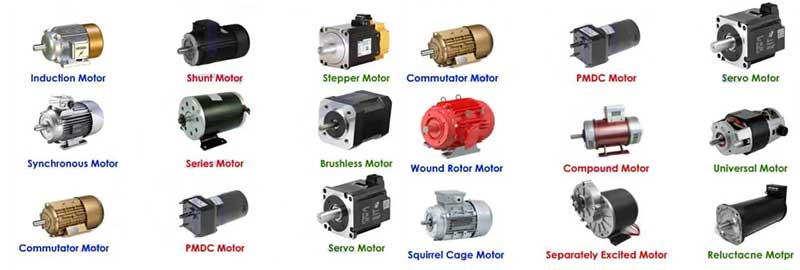
How do lifting cranes help improve safety during motor handling?
- Cranes play a crucial role in improving safety during motor handling. They are designed to lift and move heavy loads, including motors, in a controlled and safe manner. By using lifting cranes, workers can avoid manually handling heavy loads, which can cause injuries such as strains, sprains, and back pain.
- Cranes also offer precise control over the movement of the load, allowing for safe and accurate placement of motors in their intended location. This reduces the risk of accidents and damage to the motor or surrounding equipment.
- Furthermore, The motor handling cranes can be equipped with various safety features such as limit switches, overload protection, and emergency stop buttons. These features help prevent accidents and ensure that the crane operates safely and efficiently.
In summary, The motor handling cranes are essential tools for motor handling as they improve safety by reducing the risk of injuries and accidents, providing precise control over the movement of the load, and offering various safety features to ensure safe operation.
Benifits of lifting crane for motor handling
What are the benefits of using lifting cranes for motor handling compared to other methods? Using lifting cranes for motor handling has several benefits compared to other methods, such as:
- Efficiency: The motor handling cranes are designed to lift and move heavy loads quickly and efficiently, which can save time and increase productivity.
- Safety: The motor handling cranes are equipped with safety features such as limit switches, overload protection, and emergency stop buttons, which can help prevent accidents and injuries.
- Flexibility: The motor handling cranes come in various sizes and configurations, making them suitable for different types of motor handling tasks and environments.
- Cost-effective: While the initial investment in a crane may be high, the long-term cost savings can be significant compared to other methods that require more labor or equipment.
- Reduced damage: lifting cranes can move motors without causing damage to the motor or surrounding equipment, which can reduce repair and replacement costs.
Overall, using lifting cranes for motor handling can provide a safer, more efficient, and cost-effective solution compared to other methods.
Weight limits of lifting cranes used for motor handling
The weight limits of lifting cranes used for motor handling can vary depending on the specific crane being used. However, in general, lifting cranes used for motor handling are designed to lift and move heavy loads, often weighing several tons. The weight capacity of a crane is typically determined by its size and lifting capacity, which can range from a few hundred pounds to several thousand pounds. It is important to consult the manufacturer's specifications and guidelines when determining the appropriate weight limit for a specific crane. Additionally, it is crucial to follow proper safety protocols when operating lifting cranes to prevent accidents or injuries.
Examples of lifting cranes for motor handling
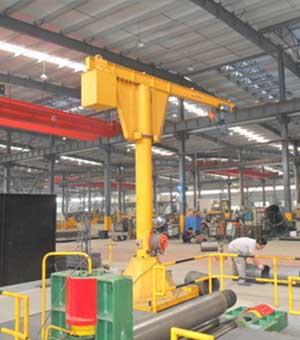
Mobile jib crane
Mobile jib crane (also known as: rolling jib crane, movable jib crane, small jib crane on wheels), it is a small jib crane. The mobile cantilever crane is more flexible and adaptable, and it is a necessary separate emergency hoisting equipment for high-efficiency automatic production lines. With it, it can ensure that the production line is unimpeded.
The mobile jib crane is equipped with an electric chain hoist (or wire rope electric hoist) on one end of the 300° slewing jib for lifting operations on goods or work-pieces: the other end is provided with a counterweight, which rotates at the same time as the jib. Play a balancing role. Widely used in factories, mines, workshops, field, warehouse small equipment installation. Loading and unloading of goods and work-pieces, and places where low buildings are not suitable for the installation of overhead crane and bridge cranes.
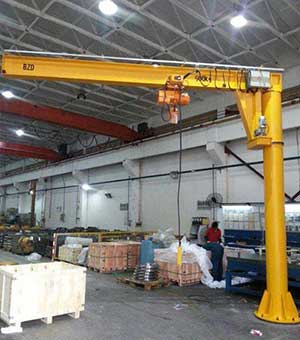
Floor mounted column jib crane
The floor mounted column jib crane (also known as: column jib crane,pillar jib crane, freestanding jib crane, floor mounted jib crane). It is a new generation of light lifting equipment made to adapt to modern production. It is equipped with electric chain hoist with high reliability, especially suitable for short distance, frequent use and intensive lifting operations. Small area, easy to operate and maintain. It can be widely used in factories, mines, workshop production lines, assembly lines and machine tool loading and unloading, as well as heavy lifting in warehouses, docks and other occasions.
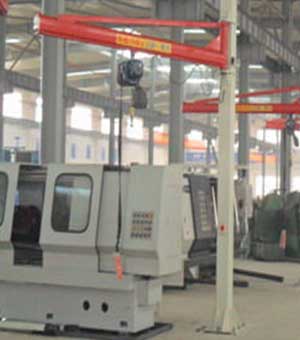
Light duty jib crane
The light duty jib crane with no foundation has a lifting capacity of 500KG, mainly including upper column, lower column, main beam, main beam tie rod, lifting mechanism (electric chain hoist), slewing mechanism, electrical system, ladder and maintenance platform. They are widely used for light loads handling with weight no more than 500kg. Compared with heavy duty floor mounted jib crane, they can be installed on the concrete ground with thickness of 20 cm by bolts, which is more cost-effective.
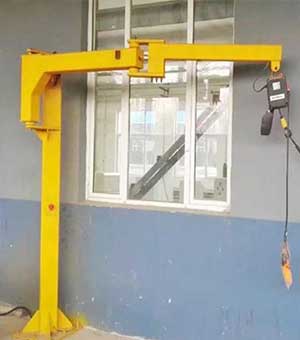
Articulated jib crane
Articulated jib crane (also known as: articulating arm crane, curved arm crane, folding arm crane, articulating arm jib crane, ) articulating jib crane has a novel structure, It has the characteristics of free extension and flexion, convenient operation, high efficiency and energy saving. During operation, press the button to lift the load, and use the bending and rotating movement of the beam to avoid objects in the controlled work area and make full use of the work area. Push and pull gently by hand to reach any position in the work area.
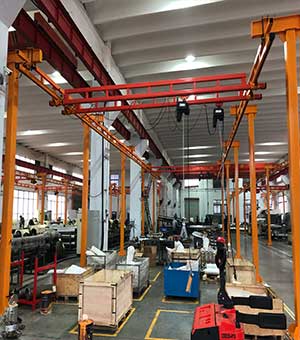
Flexible light suspension crane
Flexible light suspension crane system -The lifting capacity of the flexible light combined suspension crane is 125kg-2000kg.The flexible light combined suspension cranes include monorail suspension cranes, single-girder suspension cranes, double-girder suspension cranes, telescopic beam suspension cranes, stackers and other forms, The application range is extremely wide, especially suitable for modern production conveyor lines.




